The aim: to get my Lenovo IdeaPad S10-2 netbook to allow me to boot into Mac OS X, Windows XP or Ubuntu Netbook Remix as and when I need each OS – and to get a nice clean Windows install at the time, free of all the crud that comes with a factory-installed OS.
Ingredients
The easy way to do this would be with a USB DVD writer. I couldn’t get one (not one that worked, any way) but I did have an old DVD ROM drive and a USB IDE caddy/enclosure gizmo. I also used:
- 2 blank DVDs
- 2 blank CD ROMs
- A G4 PowerBook to burn the discs on – any computer with a DVD burner will do
- A 4GB memory stick
- an ethernet cable
- A copy of MSIWindOSX
- A few files you’ll find mentioned on this web page – stick them on a USB stick
- A nice, cheap, large new 3.5″ SATA drive (optional – if you want to keep the original WindowsXP drive). I got a 250gb one off Amazon for around 30 quid.
First up – you need to prepare about 4 discs you’ll need. Do this with your working normal XP machine.
Download MSIWindOSX.iso off the interweb – of course I didn’t do this as this would be very naughty. Do (or rather don’t) burn it onto a DVD. It’s just under 4GB (which is why I needed a 4GB USB stick).
Then copy all the drivers in the DRIVERS folder on your IdeaPad’s D: drive onto another DVD-ROM. They don’t quite fit on a CD-ROM.
Next make a live CD of your Linux of choice – I chose Ubuntu Netbook Remix.
Last, but not least, you need to make a WindowsXP Home Edition install disc. This is fun. Well, okay, it’s not fun. It takes ages and will have you screaming at Lenovo for not supplying a Windows disc with the IdeaPad. Basically I followed this method:
http://forums.lenovo.com/t5/IdeaPad-S-series-Netbooks/Guide-Create-Recovery-Media-for-an-Ideapad-S10/
and this method (bearing in mind you need to include Service Pack 3 as well):
http://www.howtohaven.com/system/createwindowssetupdisk.shtml
But that’s not enough. If you make a disc this way, it should boot but it won’t find the hard drive as it’ll be missing the drivers needed to see a SATA hard drive. There are two ways round this: you can fiddle with the BIOS settings and change the SATA controller to compatibility mode and change it back again when you’ve got the right drivers installed. I didn’t fancy this so I used a bit of free software called nLite to tweak the XP installer I made to include SATA drivers. There should be some info here. I think this is totally legal as I have paid for a WindowsXP licence, the licence sticker is on the machine I’m installing it on – it’s just that Lenovo are too cheap to supply a disc so you have to make your own.
As I didn’t have a USB DVD writer, rather than burning the disc on the IdeaPad, I made an ISO image which I put on a USB memory stick and burnt the image using Disk Utility on my PowerBook G4.
Okay. Survived that? Now back up everything you want to keep off your IdeaPad. Go to bed, wake up the next day and do it again because you will have missed something.
Method
I tested my discs in my USB DVD reader to check they booted – press F12 at startup when you see the Lenovo splash screen and choose the USB disc as the boot device. If they boot – good news. Don’t install anything. At this point I replaced the 160GB hard drive with a cheap 250GB from Amazon – it was marketed as being for a Playstation3 I think and was only about 30 quid.
Unscrew the large panel underneath, remove the single screw holding the hard drive in, and pull to the left using the plastic flap. Unscrew the drive from its caddy, replace and re-insert.
Phew! Time for a cup of tea.
Mac OS X
Then I put (or rather I didn’t) the MSIWindOSX boot disc in the USB DVD-ROM drive, plugged it in, turned the IdeaPad on and pressed F12 at the Lenovo splash screen and chose the USB disc drive from the boot menu.
I more-or-less followed these instructions:
http://www.netbooktech.com/2008/10/13/guide-to-installing-os-x-on-lenovo-ideapad-s10/
but some things were different…
First of all before installing OS X I used Disk Utility on the install disc to make a 40GB MacOS Journalled partition on the drive. I left the rest blank – the plan is later to make a roughly 150GB NTFS partition for WindowsXP and a 40ish GB partition for Linux. The idea is to make the NTFS partition the largest one as I plan to use this as a data volume, hoping that both OS X and Linux will be able to mount it. I also used the Advanced option in DiskUtility to choose a Windows style bootloader. Not sure if this was required, it just seemed like a good idea.
I didn’t have the problem mentioned on NetbookTech about getting stuck in a loop – I said I didn’t have a Mac to transfer information from and it all went ok. I followed the instructions on getting WiFi working and that worked ok. I tried to do a system update but rather than updating from 10.5.4 to 10.5.5 I was offered a 10.5.8 combo update. This KILLED the OS X install and I had to start again – so don’t update to 10.5.8!
There’s no audio, but there is a workaround for this, though it does need Developer Tools installing which you’ll need to get off an install disc or download.
When I’m cleaning Windows…
To get Windows installed, I repeated the process, booting off the Windows CD I’d made. I used the installer to make a 150GB NTFS partition to put XP on, and left the rest blank. When installed, I copied all those files that were in the DRIVERS folder on your original D: drive back onto the C: drive and installed them to get the WiFi, graphics card, sound card etc working properly.
There’s a nice clean Windows install! Next – time to get some Linux cooking.
Ubuntu: brown is the colour!
Last of all I booted from my Ubuntu Netbook Remix CD and installed this flavour of Linux on the remaining unformatted drive space. As mentioned before, you need to use the ethernet cable to connect to the internet to get the restricted Broadcom driver in order to get WiFi to work.
Here’s what I ended up with, the choice of WindowsXP, Ubuntu or OS X at startup:
UPDATE: After installing Ubuntu, OS X doesn’t want to boot. Lots of scrolling text then stuck on a pale blue screen of death. Ho hum. Will try to re-install OS X!
UPDATE TO THE UPDATE: Yay! I got it working again. Re-installing OS X didn’t work, so I replaced the GRUB2 bootloader that comes with Ubuntu 9.10 with legacy old-skool GRUB. There’s a guide here. Legacy GRUB is much simpler to manually configure and get OS X booting OK.
During the process of retro-grading GRUB I made a note of what my partitons were numbered (yours will probably be different):
disk = /dev/sda
sda1 = HFS+ (Mac OS X)
sda2 = NTFS (WindowsXP)
sda5 = Linux
sda6 = Linux swap
Then when legacy GRUB was working I added these lines to menu.lst in /boot/grub. Note that your root settings will probably be different depending on your partition scheme and also I had to reduce the partition numbers by 1 – the WindowsXP partition hd0,1 is actually sda2 and the OS X partition hd0,0 is actually sda1 – confused me when it all went wrong the first time!
title WindowsXP
root (hd0,1)
makeactive
chainloader +1
title Mac OS X
root (hd0,0)
makeactive
chainloader +1
I left the automagic kernals stuff to look after booting into Ubuntu, and didn’t add a line for that. (Well I did actually – it didn’t work, so I took it out. I found it easier to configure GRUB for OS X than for Linux!)
The other thing I would have done differently in hindsight is to create a 4th common data partition for music, photos and videos in FAT32 format – I think this would be more easily accessed for reading and writing by all 3 operating systems. OS X doesn’t want to write to the NTFS WindowsXP partition – it can read it just fine, though. Ubuntu doesn’t have many qualms about writing to NTFS disks but then I have had problems with this when I was using WUBI, so maybe OS X’s caution is wise.
Next I’ll try and get audio working using Audieee. And annoyingly, I noticed the Ideapad’s built-in web cam works in iChat but not in PhotoBooth (I’d rather it were the other way round).
Having installed OS X I am slightly left wondering why I did it. Like climbing a mountain and saying “well the view’s quite nice but was it really worth the bother…?” It was an interesting challenge and quite exciting to see the OS X Finder on my IdeaPad but I am struggling a bit to think of a Mac-only application that makes it worthwhile. Most of the software I use is already free and cross-platform. Possibly iPhoto (which I don’t have!) – but then Cheese in Ubuntu is fine and it has the benefit of actually seeing my webcam. Would an iPhone development kit work on it? OS X also makes networking my Lenovo Ideapad with my other Macs much easier. But that’s about it…

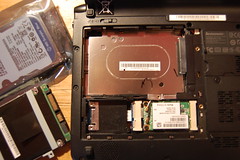

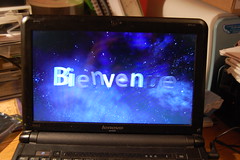
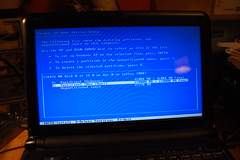

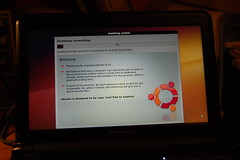
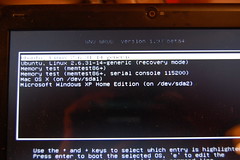
good job and nice guide, but why would u want all three os’s? lol
hey, that’s nice. but has anyone managed to find a video driver for osx
This is a great post.
I am thinking of installing:-
Windows XP
Windows 7
Mac os X
Opensuse 11.2
Ubuntu
And will probably have the following partitions:-
1 x NTFS – Windows Partition
1 x HFS – Mac Os X
1 x SWAP – For both Ubuntu + Opensuse
1 x TMP – For both Ubutu + OPensues
1 x ext3 or ext4 – Opensuse
1 x ext3 – Ubuntu
1 x VFat/FAT32 – For shared resources amongst all of the systems
Will keep you posted how things go…
Helloo friend . Nice guide. I need some help. I have crashed my hard disk and cnt install xp . Can u please provide me the xp recovery disc for ideapad s10-2. Thanks. My email is drchetanmaan.cm@gmail.com.
Hi there – I don’t think I have the drivers that you’d need any more. My Lenovo is now just dual-boot OS X Snow Leopard and XP, if it dies and I can’t re-install OS X I would probably try and put some kind of Linux in it.